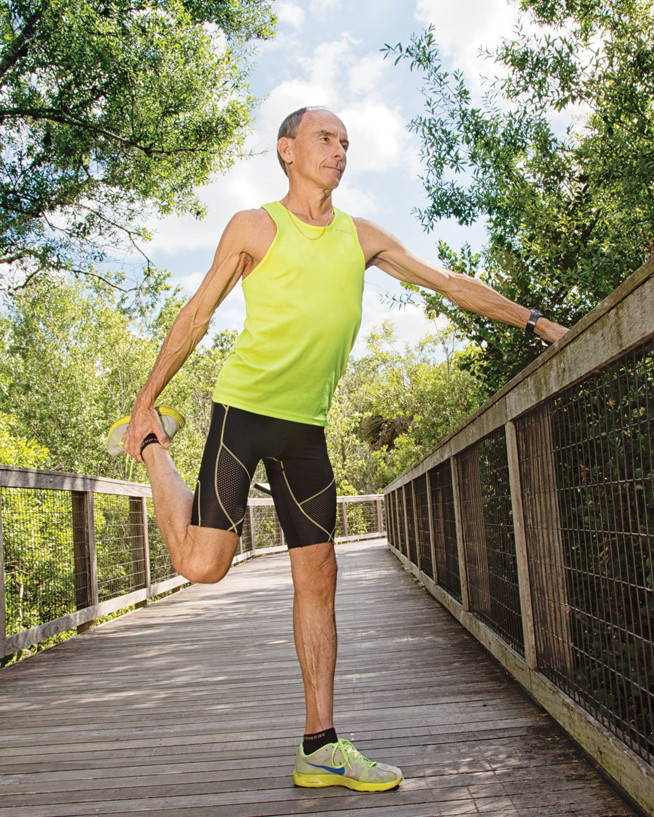Ready to run? First, make a plan — one that includes stretching.
Speedsters Running Club President and elite runner Perry Small shows you how.
Behind every great runner, there’s a great training plan. And whether you’re a newbie to the sport or an elite athlete, a solid plan is the first step — literally — to improved running.
I’ve outlined three basic eight-week training plans based on your current level of fitness. Since every runner has different abilities and running histories, these plans should be used as general guidelines to help you gain consistency in your workouts. Once you’ve established more time-specific goals, a more detailed plan with paces can be applied.
Common workout terms:
Fartlek (Swedish for “speed play”): Sprinting and jogging off and on during a run.
Hills/Bridges: Running at least a ¼ mile up a hill or bridge and over, repeating as necessary.
5K Plan for Beginners
This plan is designed for someone who has been exercising at least four times a week for at least two months, averaging at least nine miles a week with a long run of three miles. Before you start this program, you should be able to run 30 minutes without stopping. (Need extra motivation? See why running with a group can improve your performance.)
Weekly routine: 4 workouts, 1 day rest, 2 days optional cross-training or rest. Each daily run at 2-4 miles to include one day of 2 miles easy pace over a hill/bridge twice or a Fartlek of 1 mile easy, then surging ¼ mile fast, ¼ easy, ¼ fast, ¼ easy, ¼ fast ¾ easy (never stopping). Total: 3 miles.
5K Plan for Intermediate Runners
Geared toward runners who have at least one 5K race under their belts and want to finish faster. You should be regularly running four to five times per week with a total weekly mileage of at least 16 miles (including a long run of at least six miles).
Weekly routine: 4 workouts, 1 day rest, 2 optional cross-training or rest days with each run consisting of 3-5 miles (including one day of 5 miles easy pace over hills/bridges OR a Fartlek of 1 mile easy, then surging ¼ mile fast, ¼ easy, ¼ fast, ¼ easy, ¼ fast ¼ easy ¼ fast, 1¼ mile easy never stopping). Total: 4 miles.
5K Plan for Advanced Runners
For runners who regularly log at least five to six runs per week, average 30 miles per week, and can complete a long run of at least 10-14 miles.
Weekly routine: 5-6 workouts, 1-2 days rest. Each run consists of of 4-6 miles daily, including one 6 miles easy pace of Hills/bridges OR Fartlek (first mile easy, ¼ mile fast ¼ mile easy for 3 miles then 1 mile easy). Total: 5 miles
Mile Repeats: Complete these at 15-20 seconds faster per mile than your target race pace.
Stretching Plan
When runners take on a training program, they tend to focus on building up their mileage, adding speed workouts to run faster and longer. Improving their flexibility through stretching oftentimes never makes it into training. Yet, a flexible body is more efficient, helps you gain strength and endurance, enjoy a better range of motion, is less injury-prone, recovers more quickly, and simply feels better.
One reason many runners avoid stretching is because they’ve heard it’s bad or unnecessary. True, when muscle fibers are stretched, they lose their ability to function properly and can create delayed onset muscle soreness. However, the goal of stretching should be to lengthen our muscles. This fills our legs with blood and oxygen, which rebuilds the neurological pathways, restores muscles that have become torn, and realigns postural imbalances.
Along with training smart and choosing the right shoes, stretching ranks right up there as the most important thing you can do to protect your body from the rigors of the road, at least for me. That’s why I personally make stretching a core part of my training plan following every run or race. In fact, a good, consistent stretching program can actually keep you running when you might otherwise become injured. Also, stretching can help reduce muscle soreness after training runs and races.
One note of caution, however: be careful about how you stretch. If not done properly, stretching can actually cause injury rather than prevent it.
Here are some things to avoid:
• Don’t stretch before you start your run. Rather, jog easily for about 10 minutes to warm up your muscles.
• Don’t bounce, since bouncing risks pulling or tearing the muscle you’re trying to stretch and relax. Muscles must be stretched gradually. If a stretch is applied too quickly, the muscle responds with a strong contraction, increasing tension. If the stretch is applied slowly, however, this contraction reflex is avoided, muscle tension falls, and you may stretch the muscle further.
• Don’t stretch beyond the point where you begin to feel tightness in the muscle.
• Don’t stretch to the point of discomfort or pain.
These are the stretches that I do after every time I run. I know it helps me personally to feel better, stay looser, and prevent injury. If you feel sore and tight after your training runs or races, you may want to give stretching a try; it made a believer out of me and I hope it does the same for you.
Note: Be sure to hold each stretch for about 30 seconds.
 Calves: Stand about three feet from a wall, pole, or car, with feet shoulder-width apart and flat on the ground. Put your hands on the wall with your arms straight for support. Lean your hips forward and bend your knees slightly to stretch your calves.
Calves: Stand about three feet from a wall, pole, or car, with feet shoulder-width apart and flat on the ground. Put your hands on the wall with your arms straight for support. Lean your hips forward and bend your knees slightly to stretch your calves.
 Hamstring: Lie down with one leg straight up in the air, the other bent with foot flat on the ground. Loop a towel over the arch of the lifted foot, then gently pull on the towel as you push against it with your foot. Push only to the point where your muscles contract. Repeat with the other foot.
Hamstring: Lie down with one leg straight up in the air, the other bent with foot flat on the ground. Loop a towel over the arch of the lifted foot, then gently pull on the towel as you push against it with your foot. Push only to the point where your muscles contract. Repeat with the other foot.
Quadriceps: Stand on one foot, with one hand on a wall for balance. Hold the other foot with the opposite hand and raise the heel of the lifted foot to the buttocks (or as close as comfortably possible) to stretch your quadriceps. Keep your body upright throughout the stretch. Change legs and repeat.


